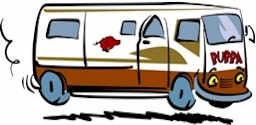Valley Forge received its name from an iron forge built along Valley Creek in the 1740's. By the time of the Revolution, the British had destroyed the forge, along with the sawmill and gristmill that had been added. Only ruins remained at the time of the encampment. At the Visitor Center, we watched an 18-minute film that provided an introduction to life during the encampment. Displays and artifacts in the exhibit area illustrated what life was like in the camp. They also had a kiosk where you could research whether any of your relatives had been at Valley Forge. There were no Linebargers but there were four Browders (my maiden name) on the Valley Forge Muster Roll: Frederick, Harrison, Samuel, and Ishan, all from Virginia. I was so proud!
Valley Forge was the first encampment in which the Continental Army suffered severe and general hardship due to a poorly administered supply system. With the depreciation of Continental currency and inflated prices during the winter months, the Army had to resort to innovation and self-sufficiency in order to carry on. They built
12 X 16 huts where 12 men slept so they were reasonably warm but food, clothes, and other supplies were scare. Conditions began to improve with the advent of spring, and the forceful leadership of Nathaniel Greene as Quartermaster General. Greene left no stone unturned. He located supplies and routed them to camp.
They picked Valley Forge because, from this location, 20 miles northwest of British-held Philadelphia, Washington could maintain pressure on the enemy dwelling in the patriot capital and yet be far enough away to prevent a surprise attack by the Brits. From here, the Continental Army could also secure the outlying parts of the state.
Valley Forge was the third of five winter camps. While it was not the hardest of the encampments, it was the turning point in that it was during this time that we cemented our relationship with France and worked out a better supply system. It was here that the Continental rag-tags became a real army under Lt. Gen. Baron Von Steuben, recruited from the Prussian Army. There were about 12,000 soldiers there when the Encampment started but over the winter months, they lost about 6,000 through death, desertion, and expiring enlistments. One in ten soldiers at Valley Forge died, nearly all from disease. However, by the spring of 1778, the number of soldiers had swelled to 20,000.
We visited General Washington’s headquarters, rented during the encampment from owner Isaac Potts who built the house in 1773. Martha visited George here. The house is 95% original, including the handrail that leads to the second story bedrooms. It was almost a religious experience to touch the very handrail that Washington touched almost 229 years ago. It was also very moving to see George’s 5-star General flag in the yard. Wow.
After our visit, we looked at Valley Forge differently - not as a place filled with starving troops but as the birthplace of the U.S. Army and a proving ground for true soldiers.
At the conclusion of our visit to Philadelphia, we just had to try out Pat’s and Geno’s cheesesteaks so we drove to the Italian part of town one day and ordered a sandwich at both places and shared them. Kathi and Dale are absolutely right . . . the others can’t hold a candle to Jimmy’s. If you go to Philly – don’t miss Jimmy’s on South Street.
Happy trails . . . til we meet again!
Church signs along the way:
Satan tricks us but God gives us treats.
When we are down to nothing, God is up to something.
There’s a difference between free speech and cheap talk.

